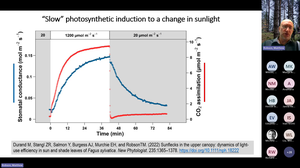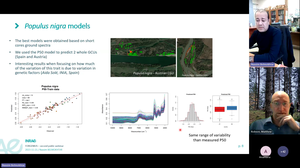Modelling for the future: light adaptation between leaves and high-throughput phenotyping

There have been changes in physiological and morphological processes in the leaves which have led to a reduced efficiency in high radiance. Dr. Matthew Robson, our feature speaker, explained his conclusion in the second FORGENIUS public webinar, held on 21 November.
This reasoning comes from observing that there is almost an immediate change in photosynthesis when a bright light is switched on and when it’s switched off but a lag in the stomatal conductance.
On average, when looking at the irradiance received between a fluctuating environment and a steady light environment, the leaves tend towards the morphology of sun leaves even when they receive the same amount of light that is fluctuating as they would have received in a steady light environment. “This is an interesting finding and might explain why we have less efficiency in fluctuating than in steady light but still we don't know whether this is a long-term process or a short-term process”. Understanding canopy-level light use efficiency and the traits that determine this according to light fluctuations in the canopy is the key to predicting how forests will respond to future changes in light conditions.

Project member Dr. Nassim Belmokhtar talked about the advances obtained assessing the potential of Near Infrared Spectroscopy technology associated to chemometric approaches for the development of predictive models as part of the project’s work on high-throughput phenotyping. NIRS works by affecting the molecules’ vibration motion and, depending on the chemical composition of the material, elucidates molecular information. It’s a fast and reliable analytical technique which requires minimal or nonexistent sample preparation.
Dr. Belmokhtar and a team of researchers have developed NIRS models for Populus nigra and Pinus pinaster and expect to deliver models for Pinus sylvestris and Fagus sylvatica, as well as setting up a new multispecies approach.
Follow the project on social media at @FORGENIUS_EU and subscribe to the newsletter!
Watch the webinar recording!